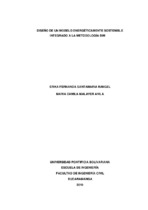| dc.contributor.advisor | Suárez Santos, Jherson Mauricio | |
| dc.contributor.author | Santamaria Rangel, Erika Fernanda | |
| dc.contributor.author | Malaver Ávila, María Camila | |
| dc.coverage.temporal | 2019 | |
| dc.date.accessioned | 2021-05-10T19:14:20Z | |
| dc.date.available | 2021-05-10T19:14:20Z | |
| dc.date.issued | 2019 | |
| dc.identifier.uri | http://hdl.handle.net/20.500.11912/8482 | |
| dc.description | 80 páginas | spa |
| dc.description.abstract | Este proyecto de grado propone diseñar un modelo energéticamente sostenible incluyendo el uso de la metodología BIM, en el municipio de Floridablanca, para evaluar el diseño arquitectónico y el análisis de rendimiento. Otra de las relaciones para el mismo, sería la utilización del Green Building Studio (Insight) el cual ayudó a la realización de los cálculos energéticos precisos y necesarios en la construcción. Se trabajó diferentes materiales como el vidrio, mampostería y vidrio-mampostería, para realizar una previa comparación del rendimiento del edificio con cada material; para esto se importó a lnsight las modelaciones para ver por medio de gráficas de barras el costo que cada modelo tenía con su respectivo material y tener en cuenta si es viable añadir o quitar elementos que contribuya mejorar la sostenibilidad del edificio. Adicionalmente se muestra el modelo apto y recomendable que determina que material es rentable y favorable con el medio ambiente para el uso en la edificación. | spa |
| dc.description.abstract | This degree project proposes to design an energetically sustainable model including the use of the BIM methodology, in the municipality of Floridablanca, to evaluate architectural design and performance analysis. Another of the relationships for it would be the use of the Green Building Studio (Insight) which helped to carry out the precise and necessary energy calculations in the construction. Different materials were worked on, such as glass, masonry and glass-masonry, to make a previous comparison of the performance of the building with each material, for this, Insight modeled to see by means of bar graphs the cost that each model had with its respective material and take into account if it is feasible to add or remove elements that contribute to improve the sustainability of the building. Additionally, the suitable and recommended model is shown that determines which material is profitable and favorable to the environment for use in the building. | eng |
| dc.format.mimetype | application/pdf | |
| dc.language.iso | spa | |
| dc.publisher | Universidad Pontificia Bolivariana | spa |
| dc.rights | Attribution-NonCommercial-NoDerivatives 4.0 International | * |
| dc.rights.uri | http://creativecommons.org/licenses/by-nc-nd/4.0/ | * |
| dc.subject | Energía sostenible | spa |
| dc.subject | Diseño | spa |
| dc.subject | Rendimiento | spa |
| dc.subject | Construcción | spa |
| dc.subject | BIM | spa |
| dc.subject | Floridablanca (Santander, Colombia) | spa |
| dc.title | Diseño de un modelo energéticamente sostenible integrado a la metodología BIM | spa |
| dc.type | Trabajo de grado | spa |
| dc.publisher.department | Escuela de Ingenierías | spa |
| dc.publisher.program | Ingeniería Civil | spa |
| dc.type.hasVersion | publishedVersion | spa |
| dc.description.sectional | Bucaramanga | spa |
| dc.description.degreename | Ingeniero Civil | spa |


